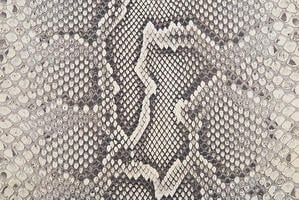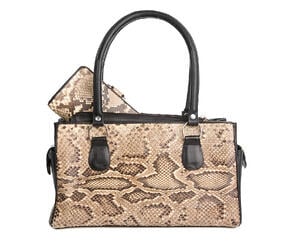 Last time, we talked about the short tail python, the smallest of the commonly-traded python species. Today, we wanted to share with you the details regarding one of the most popular, and large, python skins on the planet: the Burmese python.
Last time, we talked about the short tail python, the smallest of the commonly-traded python species. Today, we wanted to share with you the details regarding one of the most popular, and large, python skins on the planet: the Burmese python.
Measurements of the Burmese Python
Python bivitattus, or the Burmese python, is one of the top five largest snake species in the world, ranging from 2.5 meters (8.2 ft.) to 6 meters (19.6 ft.) in length, and 25 to 60 cm (9.8 to 23.6 inches) wide at their widest point.
The average size of a commercially-available Burmese python skin tends to be right around 3.25 meters (10.6 ft.) long, and 28 cm (11 inches) wide at the center, tapering down to 15 cm (5.9 inches) at the ends. The tapering of the hide is very slight until you near the end of the hide, which makes the yield size for a Burmese python of any given length a little more than the yield for a diamond python of similar length. This produces an average of 10 sq. ft. (roughly 0.93 m2) of exotic leather per hide, about twice that of the short tail python.
This large size makes the Burmese python’s hide suitable for a wide variety of large-scale leather projects, including large handbags, exotic home furniture, and vehicle upholstery. These pythons come from farms in Southeast Asia.
Appearance
 Burmese python skin has an irregular series of rounded color patterns in its scales. This creates a somewhat random, yet almost instantly recognizable pattern in the hide of a Burmese python that separates it from the more regular geometric scale pattern of the python reticulatus (diamond python).
Burmese python skin has an irregular series of rounded color patterns in its scales. This creates a somewhat random, yet almost instantly recognizable pattern in the hide of a Burmese python that separates it from the more regular geometric scale pattern of the python reticulatus (diamond python).
Unlike the other two commonly-traded types of python skin, the hide of the Burmese python has relatively narrow center belly scales, making them less pronounced than those of the short tail and diamond pythons.
Compared to the short tail python, the hide of a Burmese python is thin. This helps to make the Burmese python’s skin more malleable than the other python species.
Availability
These hides are available in both front and back cuts, and in bleached or unbleached varieties. Bleaching the python’s hide removes the iconic scale colors, but makes it easier to get an even dye color in the hide. Meanwhile using unbleached skin preserves the Burmese python’s unique scale patterns, making it easier to identify the hide as being a genuine python leather product and adding a visual flair to the final product.
Tips for Working with Burmese Python Hides
Because these skins are so valuable, you’ll probably want to get as much out of each hide as you possibly can. Since these skins are so large, odds are that you’ll have a great deal of scrap material left over from each hide. If the scraps are large enough, you could easily use them to make small accessory items such as watch straps. If you have multiple lengths of very thin hide, you could braid them together into a cord and use that to make a purse strap or some similar item.
When working with the hide of a Burmese python, keep in mind the thinness of the hide. Normally, when working with scaly reptile hides, we would recommend thinning the hide out with a dremel or other tool to reduce wear and tear on your sewing equipment. Because python hide is thinner, this is not typically as necessary.
If you do decide to thin out your sewing lines with a dremel, be very careful not to take off too much hide, or you may weaken it.
Since python scale color patterns are more irregular than diamond python color patterns, consider using bleached hides for projects that will use multiple hides for one item. This way, you can ensure a more consistent look and avoid having mismatched scale patterns running parallel in a larger piece of work. Or, you could choose to use front-cut skins so the plainer belly scales at the edges of the hide are interconnected.
For big-scale exotic leather projects, few hides are as ideal for the job as Burmese python hides. With their large size, flexibility, and popularity, these exotic hides are an ideal way to meet the needs of ultra-wealthy clients with ease.
If you want to work with Burmese python hides, or have questions about how to work with it, contact Pan American Leathers today, or check out our free Python Skin Guide at the link below:



